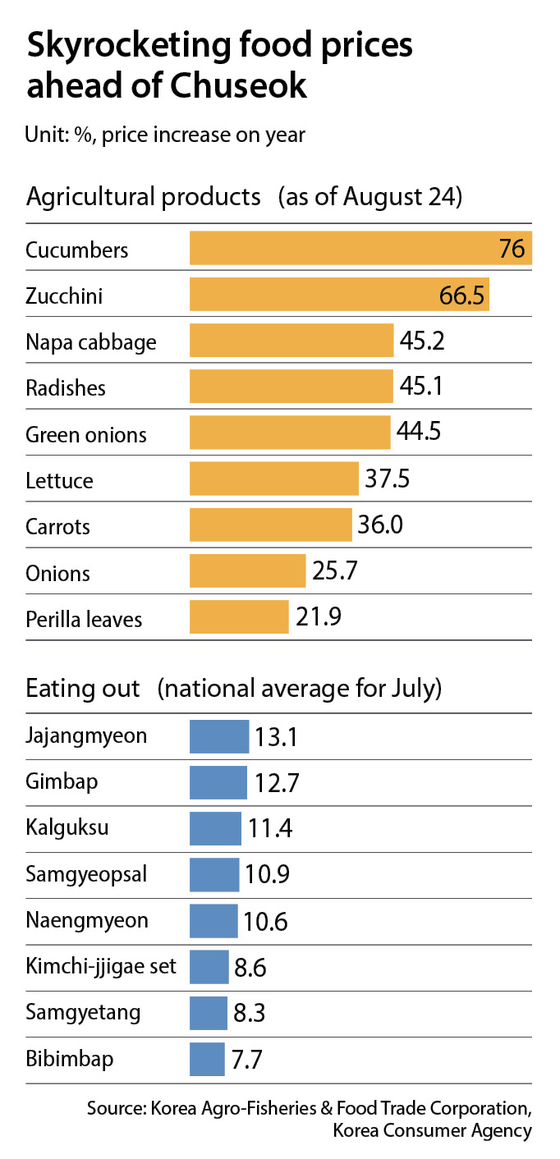If you thought Chuseok was expensive before, just wait
![A customer buys apples at the Cheongryangni Fruit & Vegetable Market in Dongdaemun District, eastern Seoul, on Thursday. [YONHAP]](https://koreajoongangdaily.joins.com/data/photo/2022/08/26/65dc7ddf-ebea-435f-ad07-44dd9e33739d.jpg)
A customer buys apples at the Cheongryangni Fruit & Vegetable Market in Dongdaemun District, eastern Seoul, on Thursday. [YONHAP]
Food is getting more expensive ahead of the Chuseok holiday, with the prices of everything from vegetables to processed foods up significantly.
Even after the Chuseok holiday season, which falls between September 9 to 12 this year, the situation is not expected to change significantly. The won, which fell to the lowest level in 13 years, is making imported goods mor expensive.
The retail price of Napa cabbage was 6,595 won ($4.95) per head as of Wednesday, according to the Korea Agricultural Marketing Information Service (KAMIS) operated by the Korea Agro-Fisheries & Food Trade Corporation.
The price of cucumbers jumped 76 percent on year, while the price of zucchinis rocketed 66.5 percent, radishes 45.1 percent, green onions 44.5 percent and lettuce 37.5 percent. The prices of carrots, onions and perilla leaves also increased.
The retail price of one kilogram of spinach was 32,002 won, up 21.5 percent from a year ago. This is even more expensive than the same amount of domestic pork belly, or samgyeopsal, which currently costs 26,160 won per kilogram. Spinach prices soared 34.4 percent on year.

“Spinach can be shipped 30 to 40 days after being planted, so prices stabilize about a month after high prices,” said an official from the ministry. “If the price goes down, less is planted and the price goes up again in repetition. This year, Chuseok is earlier than usual, and the quantity decreased further due to the high temperature in August.”
Large discount marts complain that it is not easy to lower the price of spinach.
“This year’s increase in spinach prices is mainly caused by heavy rains in Namyangju and Pocheon [in Gyeonggi], where a lot of spinach is produced,” said Baek Seung-hoon, a merchandiser at Lotte Mart’s vegetable team. “Production areas are being diversified to Jeolla, Gyeongsang and Chungcheong, but it is difficult to cut prices.”
It will cost an average of 318,045 won this year to prepare for food during Chuseok, an increase of 6.8 percent from last year, according to a survey by the Korea Agro-Fisheries & Food Trade Corporation on the prices of 28 items in 18 traditional markets and 27 large retailers across the country. This is the first time that the average cost of preparing food for Chuseok has gone over 300,000 won since the corporation started the survey.
Vegetables are not the only items getting more expensive, as processed food prices are also skyrocketing.
Nongshim announced on Wednesday that it would raise its ramyeon prices by 11.3 percent and snack prices by 5.7 percent starting from September 15, and this is only a preview.
Prices of wheat peaked on March 7 at $475 per ton, while corn was $322 per ton on April 29, and soybeans cost $650 per ton on June 9, according to the Korea Rural Economic Institute. International grain prices, which peaked between March and June, are reflected in domestic prices with a time lag. The prices of processed foods using imported grains and oils will rise further in the future.
Exchange rates are a problem. The won was 1,335.20 to the dollar as of Thursday, 6.9 won higher than the previous day.
As the Bank of Korea raised the base interest rate by 0.25 percentage points on Thursday, from 2.25 percent to 2.5 percent, it also revised the forecast for this year’s inflation to 5.2 percent, the highest in 24 years.
The increase in food prices is expected to continue until the end of the year. Even if inflation peaks in September or October, external variables, such as raw material prices and exchange rates, remain, and the extent of decline in prices is bound to be limited.
“Since oil prices and international grain prices have started to fall, the price point is expected to peak around September and October, but the exchange rate is a problem,” said Kang Kyeong-hoon, a professor of business administration at Dongguk University. “There is a risk that import prices will continue to rise due to the depreciation of the won.”
BY CHO HYUN-SOOK, BAEK IL-HYUN [lim.jeongwon@joongang.co.kr]










with the Korea JoongAng Daily
To write comments, please log in to one of the accounts.
Standards Board Policy (0/250자)